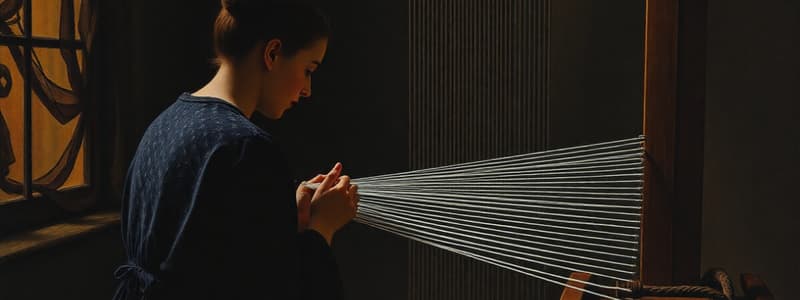Podcast
Questions and Answers
What is the primary advantage of using a compound needle in modern warp knitting machines?
What is the primary advantage of using a compound needle in modern warp knitting machines?
- To increase the productivity of the machines. (correct)
- To allow for more complex stitches.
- To support larger yarn sizes.
- To create more fabric designs.
During the knitting action, what happens after the hooks and tongues rise and the guides swing back?
During the knitting action, what happens after the hooks and tongues rise and the guides swing back?
- The sinkers start their downward movement.
- The hooks start to ascend at a slower pace.
- The old loop is immediately released.
- The guides shog for the overlap. (correct)
Which property distinguishes warp knitted fabric from weft knitted fabric?
Which property distinguishes warp knitted fabric from weft knitted fabric?
- It is more stable. (correct)
- It is softer and more flexible.
- It can only use finer yarn.
- It has sharper design capabilities.
What process occurs just before the needles begin their upward rise in the knitting action?
What process occurs just before the needles begin their upward rise in the knitting action?
Which of the following is NOT a main product of warp knitted fabric?
Which of the following is NOT a main product of warp knitted fabric?
Flashcards
Compound Needle Warp Knitting Machine
Compound Needle Warp Knitting Machine
A type of knitting machine that uses compound needles instead of traditional beard or latch needles to increase productivity.
Knitting Action (Needle Rise & Guide Bar)
Knitting Action (Needle Rise & Guide Bar)
The process where knitting needles rise and guide bars swing to create new loops in the fabric.
Knitting Action (Overlap & Return Swing)
Knitting Action (Overlap & Return Swing)
The stage of the knitting cycle where the guides shift, and hooks/tongues descend to close the new loop.
Warp Knitted Fabric Properties
Warp Knitted Fabric Properties
Signup and view all the flashcards
Common Warp Knitted Products
Common Warp Knitted Products
Signup and view all the flashcards
Study Notes
Knitting Technology: Compound Needle Warp Knitting Machine
- Compound needles are used in warp knitting machines to increase productivity.
- They replace beard or latch needles found on older machines.
Compound Needle Warp Knitting Machine Components
- Compound Needle (Main Body): A key component.
- Compound Needle (Closing Element): Part of the compound needle mechanism.
- Trick Plate: A component of the machine.
- Sinker: A component that holds and controls fabric.
- Yarn End: Yarn supply for the knitting process.
- Yarn Guide: Guides yarn to the needles.
- Fabric: The resulting knitted material.
Knitting Action (Stage 1)
- The needles rise and the guide bar moves.
- Sinkers hold the fabric down.
- Hooks and tongues rise; the hook rises faster.
- The hook head levels with guide holes and opens.
- The guides pivot to the back of the machine
Knitting Action (Stage 2)
- The guides overlap and return.
- The hooks and tongues begin to descend.
- The tongues descend more slowly to close the hooks.
Knitting Action (Stage 3)
- Sinkers start to withdraw as the needles descend.
- The old loop is placed onto the closed hook.
- The loop is then knocked over as it falls below the sinker.
- The underlap occurs before the needles rise, and the sinkers hold the fabric.
Additional Components/Details for Compound Needle Warp Knitting Machines
- Guide Bars: Part of the machine structure.
- Stitch Comb: A part of the machine, part of the needle operation.
- Closure: A component for controlling/maintaining the process of stitch formation
Comparison of Tricot and Raschel Machines
- Tricot Machines: Uses bearded needles or compound needles, finer gauge, fewer guide bars and fewer warp beams. Best for fine filaments, simple fabrics and higher production speeds. Produces lighter weight fabrics. More resilient, better drape, higher bursting strength, and better dimensional stability.
- Raschel Machines: Employs latch needles, coarser gauge, more guide bars, and more warp beams. Ideal for spun yarn or coarser fibers, more complex fabrics and lower production speeds. Produces heavier weight fabrics that are less resilient, with poor drape and lower bursting strength.
Warp Knitted Fabrics
- More stable than weft knitted materials.
- Can have big and small holes.
- Allow for diverse designs.
- Suitable for highly course yarns.
- Often used for technical fabrics like filters and seat covers.
Main Products of Warp Knit
- Nets
- Curtains
- Technical fabrics
- Covers
- Covering sheets
Use of Warp Knitted Fabric
- Used for technical purposes (e.g., filters, seat covers).
- Used as curtains and table covers.
- Used as bedsheets.
Studying That Suits You
Use AI to generate personalized quizzes and flashcards to suit your learning preferences.




